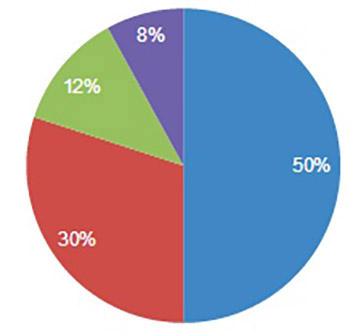Beta lactam antibiotics residues in cow's milk: comparison of efficacy of three screening tests used in Bosnia and Herzegovina
DOI:
https://doi.org/10.17305/bjbms.2014.3.109Keywords:
beta lactam residues, screening tests, cow’s milk, Bosnia and HerzegovinaAbstract
Beta lactam antibiotics are widely used in therapy of cattle, particularly for the treatment of mastitis. Over 95% of residue testing in dairies in Bosnia and Herzegovina is for Beta lactams. The aim of this paper is to compare the efficacy of three most common screening tests for Beta lactam residues in cow’s milk in our country. The tests used in the study are SNAP β Lactam test (Idexx), Rosa Charm β Lactam test and Inhibition MRL test. Study samples included: standardized concentrations of penicillin solution (0, 2, 3, 4, 5 and 6 ppb). In addition we tested milk samples from three equal size study groups (not receiving any antibiotic therapy, treated with Beta lactams for mastitis and treated with Beta lactams for diseases other than mastitis). Sensitivity and specificity were determined for each test, using standard penicillin concentrations with threshold value set at concentration of 4 ppb (Maximum residue level – MLR). Additionally we determined proportions of presumably false negative and false positive results for each test using results of filed samples testing. Agreement of test results for each test pair was assessed through Kappa coefficients interpreted by Landis-Koch scale. Detection level of all tests was shown to be well below MRL. This alongside with effects of natural inhibitors in milk contributed to finding of positive results in untreated and treated animals after the withholding period. Screening tests for beta lactam residues are important tools for ensuring that milk for human consumption is free from antibiotics residues.
Downloads
References
WHO/FAO. Glossary of terms. In: Barlow S, Renwick A, (eds.). Principles and methods of the risk assessment for chemicals in food. Geneva: WHO; 2009, A1
Samaržija D, Antunac N. Važnost dokazivanja prisutnosti antibiotičkih ostataka u mlijeku. Mljekarstvo 2002; 52(1):61-70.
Ruegg P. Antimicrobial Residues and Resistance: Understanding and Managing Drug Usage on Dairy Farms. University of Winsconsin, Dept. of Dairy Scinece, Madison, Wisconsin; 2013.
Gwet KL. Handbook of Inter-Rater Reliability: The Definitive Guide to Measuring the Extent of Agreement Among Multiple Raters: Advanced Analytics Press, 3rd edition;2012.
Landis JR, Koch GG. The measurement of observer agreement for categorical data. Biometrics 1977; 33(1):159-174.
EC Regulation 470/2009. Community procedures for the establishment of residue limits of pharmacologically active substances in foodstuffs of animal origin.
EC Regulation 37/2010. Pharmacologically active substances and their classification regarding maximum residue limits in food stuffs of animal origin.
Kantiani L, Farre M, Barcelo D. Analytical methodologies for the detection of β-lactam antibiotics in milk and feed samples. TrAC 2009; 28 (6); 729-744.
Martins T, Santos AFS, Miranda MS, Motta TP, Ambrosio LA, Pozzi CR, et al. Detection of antimicrobial residues in milk from cows with and without subclinical mastitis: microbiological testing. Proceedings of the XVth International Congress of the International Society for Animal Hygiene, Vienna, 2011: 1423-1425.
Kosikowski FV, O’Leary M. Natural inhibitory characteristics of some irish manufacturing milks. J Dairy Sci 1963;46(2):89-94.
Ghanavi Z, Mollayi S, Eslami Z. Comparison Between the Amount of Penicillin G Residue in Raw and Pasteurized Milk in Iran. Jundishapur Journal of Microbiology 2013; 6(7): e12724
Hennart SL, Faragher J. Validation report of the Delvotest Delvotest SP NT DA. Performance Tested Method 011101. J AOAC Int. 2012; 95(1); 252-260.
Cullor JS, Van Eenennaam A, Dellinger J, Perani L, Smith W, Jensen L. Antibiotic residue assays: Can they be used to test milk from individual cows?. Vet Med 1992; 87(5): 477-494.
Gibbons-Burgener SN, Kaneene JB, Lloyd JW, Leykam JF, Erskine RJ. Reliability of three bulk-tank antimicrobial residue detection assays used to test individual milk samples from cows with mild clinical mastitis. Am J Vet Res 2001;62(11):1716-1720.
Kang JH, Jin JH, Kondo F. False-Positive Outcome and Drug Residue in Milk Samples Over Withdrawal Times. J Dairy Sci 2005;88(3):908-913.
Oliver SP, Maki JL, Dowlen HH. Antibiotic residues in milk following antimicrobial therapy during lactation. J Food Prot 1990; 53 (8): 639–696.
Mercer HD, Geleta JN, Schultz EJ, Wright WW. Milk-out rates for antibiotics in intramammary infusion products used in the treatment of bovine mastitis: relationship of somatic cell counts, milk production level, and drug vehicle. AJVR 1970; 31(9):1549-1560.
Tan X, Jiang YW, Huang YJ, Hu SH. Persistence of gentamicin residues in milk after the intramammary treatment of lactating cows for mastitis. J Zhejiang Univ Sci B. 2009;10(4):280-284.

Downloads
Additional Files
Published
Issue
Section
Categories
License
Copyright (c) 2015 Bosnian Journal of Basic Medical Sciences

This work is licensed under a Creative Commons Attribution 4.0 International License.













